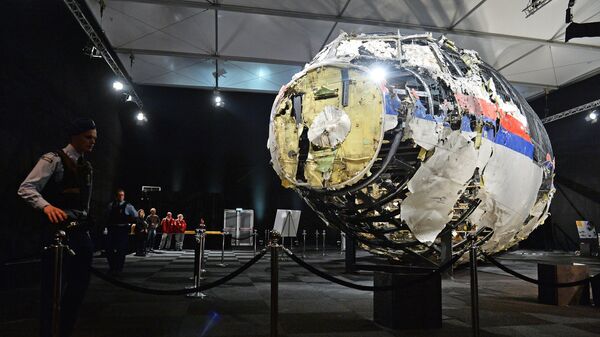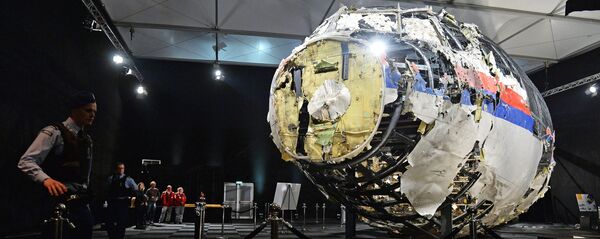On July 17, 2014, at the peak of fighting in eastern Ukraine between the Ukrainian military and anti-Kiev militia, Malaysia Airlines Flight MH17, on route from Amsterdam to Kuala Lumpur, was destroyed, killing all of 298 passengers and crew onboard. Kiev and independence supporters in Ukraine's southeast quickly blamed each other for the catastrophe. Last October, Dutch investigators published a report which said that MH17 appeared to have been shot down by a Buk surface-to-air missile system, produced by Russia's Almaz-Antey defense concern. Investigators could not conclusively determine the precise area that the missile was fired from.
Last month, Dutch officials announced that their Joint Investigation Team, working on the criminal investigation into the catastrophe, would release the first results of their investigation on September 28. Headed by the Dutch Public Prosecutor, the investigation is expected to show precisely the kind of weapon that was used, and from where it was fired.
On Tuesday, the Novaya Gazeta newspaper published a 31-page leaked document, signed by Almaz-Antei representative Mikhail Malyshevsky. The paper suggested that the report's conclusions may very well serve as the basis for Russia's possible response to the Dutch investigation; the document, prepared on the basis of an investigation by specialists from Almaz-Antei, breaks down in great detail the erroneous and sometimes outright falsified evidence presented by Bellingcat, a group of Western journalists heavily engaged in investigating the plane's destruction.
The downing of Flight MH17 has turned into one of the organization's main pet projects, and according to Dutch media, Bellingcat's work is being actively considered by Dutch investigators for their investigation.
Despite Russian investigators' thorough efforts to counter Bellingcat's claims in the past, the group has continued to persist in suggesting that anti-Kiev militia, and indirectly, Russia, were responsible for the downing of the Malaysian Boeing. As a result, Russian experts have been forced to go through great lengths to refute the misinformation presented by Bellingcat.
Another of Bellingcat's charges revolves around a satellite image showing a white transport truck carrying the rebel Buk allegedly used to shoot down the MH17 on its trailer. But that image was proven to be a fake, given that three of the vehicles Bellingcat claims were part of the Buk convoy are actually pictured going in the opposite direction along the highway depicted. Moreover, the shadow given off by the truck and its cargo is not characteristic of the Buk's distinctive shape, and is facing in the wrong direction relative to the time of day the shot was said to have been taken (11:08 AM on July 17, 2014).
Next, Russian experts dissected the claim made by Bellingcat regarding a photograph purporting to show launch smoke coming from the Buk missile in an area near the alleged launch site on July 17. According experts, this photo was either digitally altered or taken at another date, since other photo and video evidence from July 17 have confirmed that the weather in the area was cloudy, not clear, as claimed by Bellingcat.
As to the crucial Bellingcat claim – that MH17 was hit by a single Buk SAM in the hands of the Donbass militia, the report reiterated that this is a practical impossibility, since the detection range of a single Buk is limited to 120 degrees in azimuth and 7 degrees in elevation, and its effectiveness of fire is limited. A single Buk system can guard only a pre-assigned airspace sector with knowledge of its potential targets' parameters, up to and including enemy flight time (that is, to wait in 'ambush' mode). Independently and without this information, normally provided by support systems elsewhere in the military command, a single Buk is not capable of precisely locating and then hitting its target.
The detailed, technical and expert-oriented 31 page report leaked by Novaya Gazeta also revealed that Almaz-Antei took the unprecedented step of providing Dutch investigators with the genuine specifications of the Buk system. This, the report suggested, was meant to preclude the use of erroneous or otherwise inaccurate data which investigators obtained from various sources, including publically available materials. "The use of such materials inevitably led to erroneous results and conclusions. Precisely in order to avoid these mistakes, the decision was made to transfer the real technical characteristics of the Buk missile to the Dutch Safety Board," the report explained.
As for Bellingcat, the report saved a special criticism for them regarding the variant of the Buk missile used to shoot down MH17, suggesting that the group does not have and cannot know the precise technical characteristics and technical documentation which would enable them to make an accurate distinction between the variants of the 9M38 missile. As for Almaz-Antei, their report from October 2015 not only included this information, but even showed the results of two full-scale experiments to recreate the crash, conclusively demonstrating that the Malaysia Airlines Boeing was downed by an old Buk model fired from Ukrainian territory.




